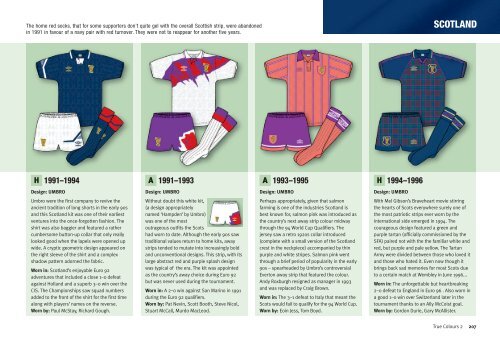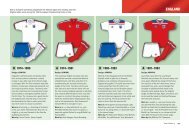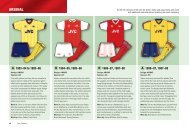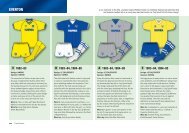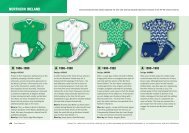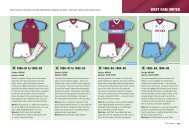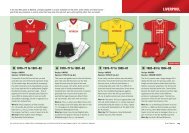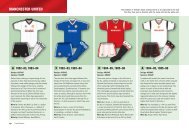Scotland - True Colours Football Kits
Scotland - True Colours Football Kits
Scotland - True Colours Football Kits
You also want an ePaper? Increase the reach of your titles
YUMPU automatically turns print PDFs into web optimized ePapers that Google loves.
The home red socks, that for some supporters don’t quite gel with the overall Scottish strip, were abandoned<br />
in 1991 in favour of a navy pair with red turnover. They were not to reappear for another five years.<br />
SCOTLAND<br />
H<br />
1991–1994<br />
A<br />
1991–1993<br />
A<br />
1993–1995<br />
H<br />
1994–1996<br />
Design: UMBRO<br />
Umbro were the first company to revive the<br />
ancient tradition of long shorts in the early 90s<br />
and this <strong>Scotland</strong> kit was one of their earliest<br />
ventures into the once-forgotten fashion. The<br />
shirt was also baggier and featured a rather<br />
cumbersome button-up collar that only really<br />
looked good when the lapels were opened up<br />
wide. A cryptic geometric design appeared on<br />
the right sleeve of the shirt and a complex<br />
shadow pattern adorned the fabric.<br />
Worn in: <strong>Scotland</strong>’s enjoyable Euro 92<br />
adventures that included a close 1–0 defeat<br />
against Holland and a superb 3–0 win over the<br />
CIS. The Championships saw squad numbers<br />
added to the front of the shirt for the first time<br />
along with players’ names on the reverse.<br />
Worn by: Paul McStay, Richard Gough.<br />
Design: UMBRO<br />
Without doubt this white kit,<br />
(a design appropriately<br />
named ‘Hampden’ by Umbro)<br />
was one of the most<br />
outrageous outfits the Scots<br />
had worn to date. Although the early 90s saw<br />
traditional values return to home kits, away<br />
strips tended to mutate into increasingly bold<br />
and unconventional designs. This strip, with its<br />
large abstract red and purple splash design<br />
was typical of the era. The kit was appointed<br />
as the country’s away choice during Euro 92<br />
but was never used during the tournament.<br />
Worn in: A 2–0 win against San Marino in 1991<br />
during the Euro 92 qualifiers.<br />
Worn by: Pat Nevin, Scott Booth, Steve Nicol,<br />
Stuart McCall, Murdo MacLeod.<br />
Design: UMBRO<br />
Perhaps appropriately, given that salmon<br />
farming is one of the industries <strong>Scotland</strong> is<br />
best known for, salmon pink was introduced as<br />
the country’s next away strip colour midway<br />
through the 94 World Cup Qualifiers. The<br />
jersey saw a retro 1920s collar introduced<br />
(complete with a small version of the <strong>Scotland</strong><br />
crest in the neckpiece) accompanied by thin<br />
purple and white stripes. Salmon pink went<br />
through a brief period of popularity in the early<br />
90s – spearheaded by Umbro’s controversial<br />
Everton away strip that featured the colour.<br />
Andy Roxburgh resigned as manager in 1993<br />
and was replaced by Craig Brown.<br />
Worn in: The 3–1 defeat to Italy that meant the<br />
Scots would fail to qualify for the 94 World Cup.<br />
Worn by: Eoin Jess, Tom Boyd.<br />
Design: UMBRO<br />
With Mel Gibson’s Braveheart movie stirring<br />
the hearts of Scots everywhere surely one of<br />
the most patriotic strips ever worn by the<br />
international side emerged in 1994. The<br />
courageous design featured a green and<br />
purple tartan (officially commissioned by the<br />
SFA) paired not with the the familiar white and<br />
red, but purple and pale yellow. The Tartan<br />
Army were divided between those who loved it<br />
and those who hated it. Even now though it<br />
brings back sad memories for most Scots due<br />
to a certain match at Wembley in June 1996...<br />
Worn in: The unforgettable but heartbreaking<br />
2–0 defeat to England in Euro 96 . Also worn in<br />
a good 1–0 win over Switzerland later in the<br />
tournament thanks to an Ally McCoist goal.<br />
Worn by: Gordon Durie, Gary McAllister.<br />
<strong>True</strong> <strong>Colours</strong> 2 207
SCOTLAND<br />
Strangely, the white 03–05 away shirt was worn at home when <strong>Scotland</strong> faced Trinidad and Tobago in a 2004 friendly.<br />
A 2002–2003<br />
H<br />
2003–2005<br />
A<br />
2003–2005<br />
3<br />
2004–2006<br />
Design: FILA<br />
Lemon yellow returned to Hampden in this<br />
minimally elegant away strip that was<br />
launched a short while after the pinstriped<br />
home shirt. The smart-looking jersey featured<br />
a streamlined crew-neck and, like the last<br />
Umbro change strip, included a simple navy<br />
chest band that housed the Fila logo and<br />
<strong>Scotland</strong> crest. The shorts and socks simply<br />
mirrored the design of the home pairs. Both<br />
this and the first choice navy kit were used for<br />
one year, with 2003 marking the end of the<br />
SFA’s three-year contract with Fila.<br />
Worn in: A 2–0 win over Iceland in the Euro<br />
2004 qualifying campaign with goals from<br />
Naysmith and Dailly.<br />
Worn by: Kevin Kyle, Steven Thompson,<br />
Maurice Ross, Scott Dobie, Paul Devlin.<br />
Design: DIADORA<br />
It was all change on the <strong>Scotland</strong> kit front in<br />
2003. Not only was there a new home and<br />
away strip from new kit supplier Diadora, but a<br />
redesigned version of the Scottish crest was<br />
also launched. It incorporated the St Andrews<br />
cross and ‘<strong>Scotland</strong>’ text above the familiar<br />
shield. Diadora’s first home kit was a<br />
competent enough affair. It featured a<br />
contemporary double-layered neck design with<br />
white fabric inserts running from the neck to<br />
under each arm. The socks reverted to a<br />
maroon-topped navy.<br />
Worn in: The magnificent 1–0 win over the<br />
Netherlands in the Euro 2004 play off 1st leg<br />
(2003). Also worn in the 1–1 draw with Moldova<br />
that led to Vogts’ departure the following year.<br />
Worn by: Paul Dickov, James McFadden.<br />
Design: DIADORA<br />
Diadora kept it simple with their first <strong>Scotland</strong><br />
away strip. Formed from a workmanlike white<br />
and navy, sophistication was added with the<br />
inclusion of reversed seams that curved<br />
anatomically down the front of the jersey along<br />
with tapered navy shoulder flashes. The curved<br />
seams continued in white on the shorts that<br />
were also worn with the home kit on occasion.<br />
Bertie Vogts left the <strong>Scotland</strong> post in<br />
November 2004 and was eventually replaced<br />
by ex-Rangers manager Walter Smith.<br />
Worn in: The not so wonderful 6–0 thrashing at<br />
the hands of the Netherlands in the 2nd leg of<br />
the Euro 2004 play offs that denied the<br />
hopeful Scots of a place in the finals.<br />
Worn by: Barry Ferguson, Steven Pressley,<br />
Darren Fletcher, Neil McCann, Gavin Rae.<br />
Design: DIADORA<br />
This fine looking amber jersey was the first<br />
official third shirt worn by a Scottish side.<br />
Consisting of a standard Diadora template of<br />
the time, the lightweight shirt featured a<br />
asymmetrical neck, angled navy mesh inset<br />
strips that aided moisture control and<br />
Diadora’s hi-tech ‘one of eleven’ shoulder<br />
flashes that changed colour depending on<br />
body temperature. The plumper members of<br />
the Tartan Army, keen for their own replica<br />
versions, were possibly a little nervous on<br />
seeing how figure-hugging the jersey was.<br />
Fortunately XXL replicas were produced.<br />
Worn in: A 3–0 home defeat to Hungary in a<br />
2004 friendly – it was the kit’s debut and the<br />
biggest Scots defeat at Hampden since 1973.<br />
Worn by: Richard Hughes, Andy Webster.<br />
210 <strong>True</strong> <strong>Colours</strong> 2


